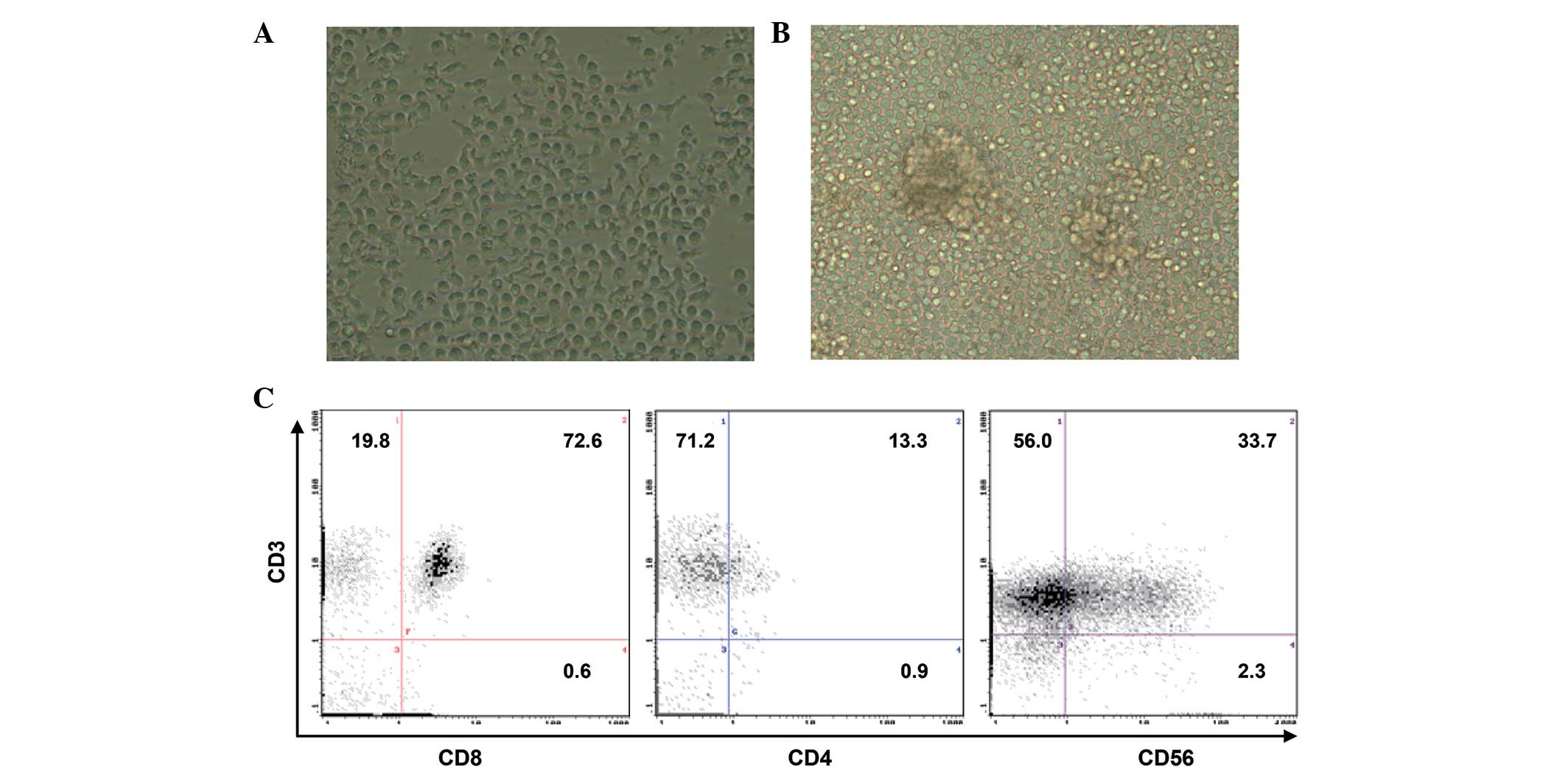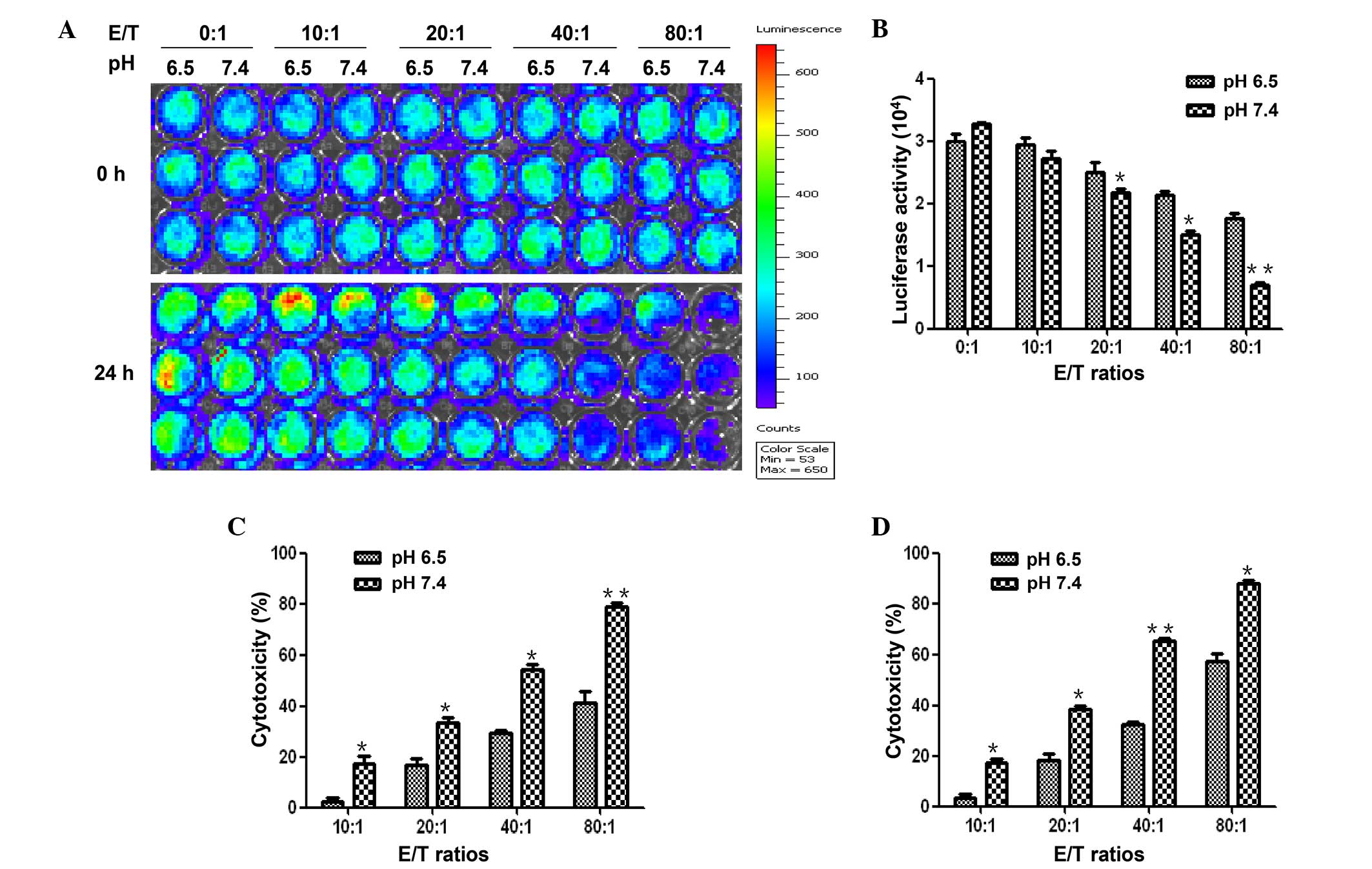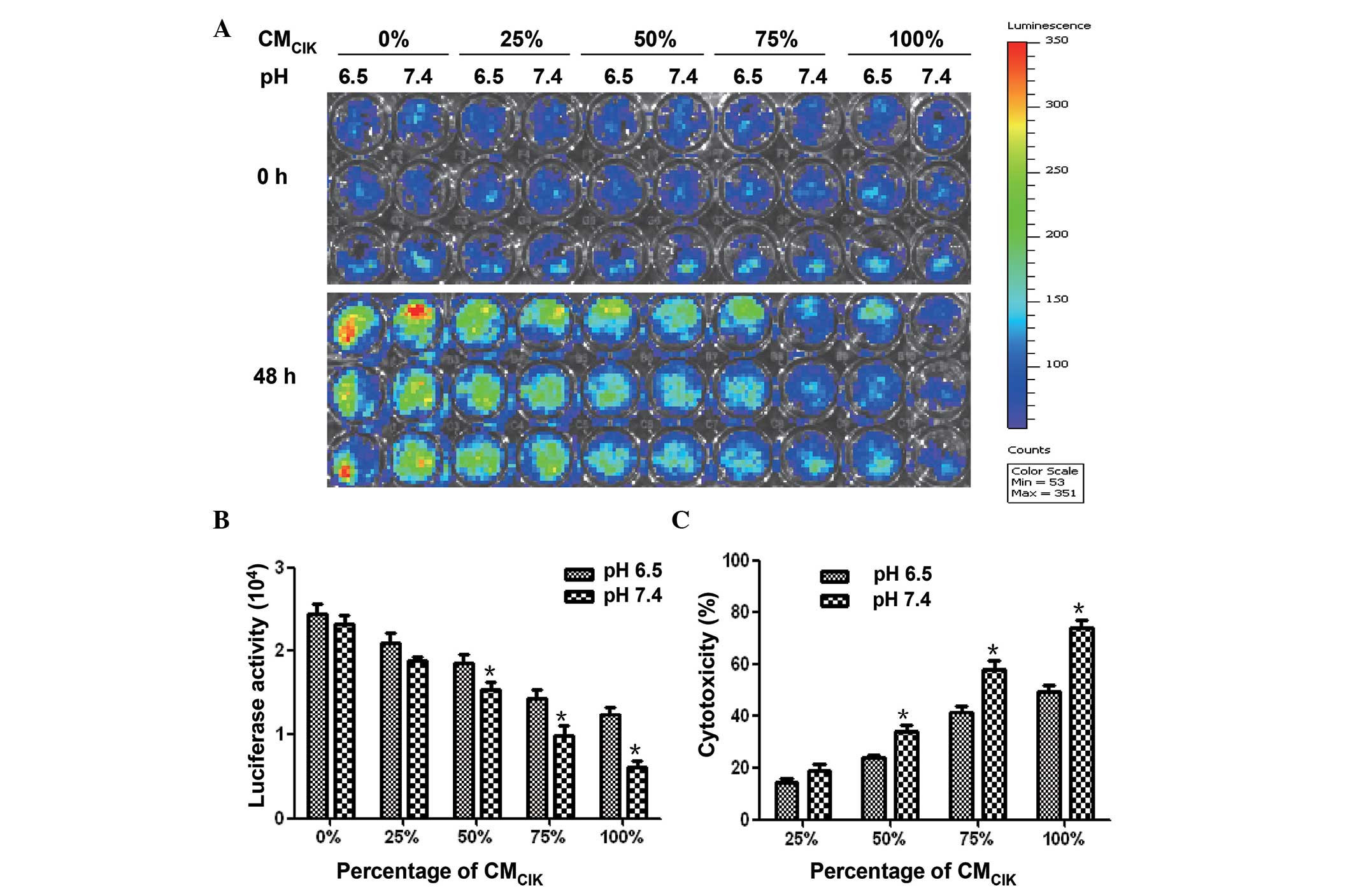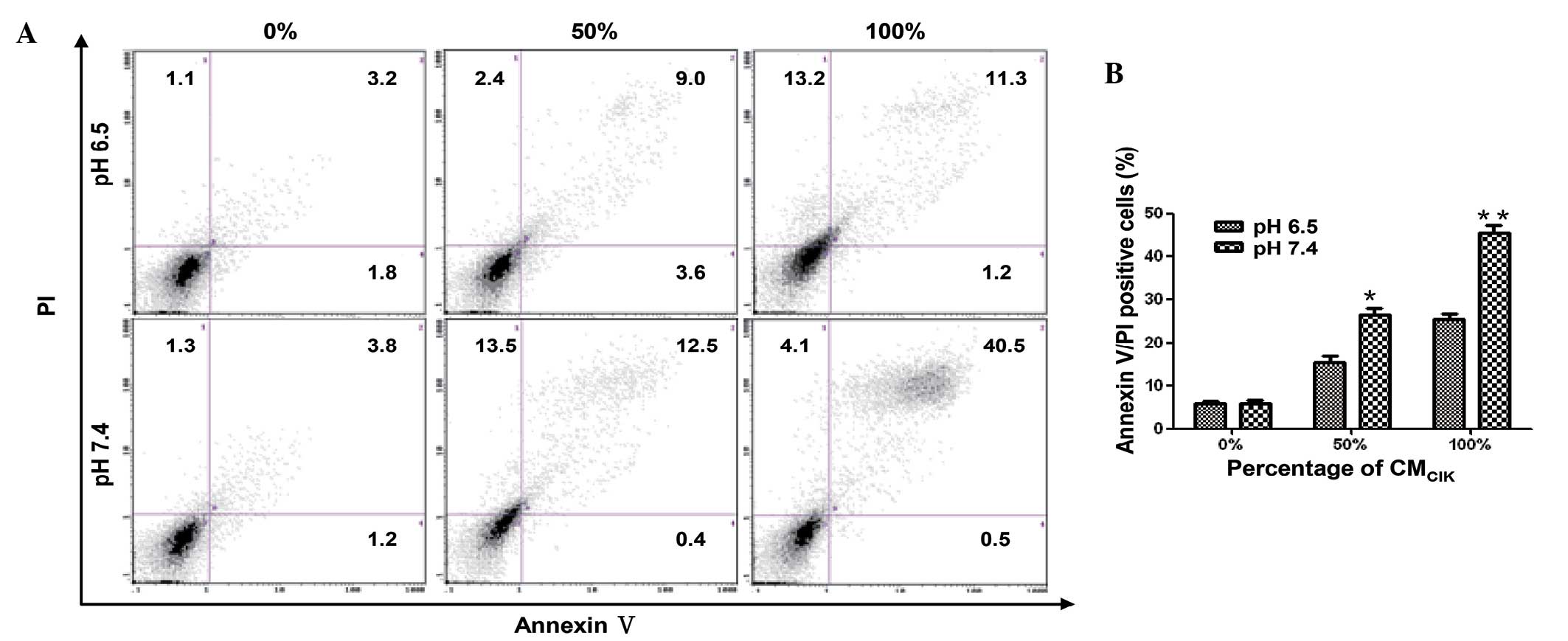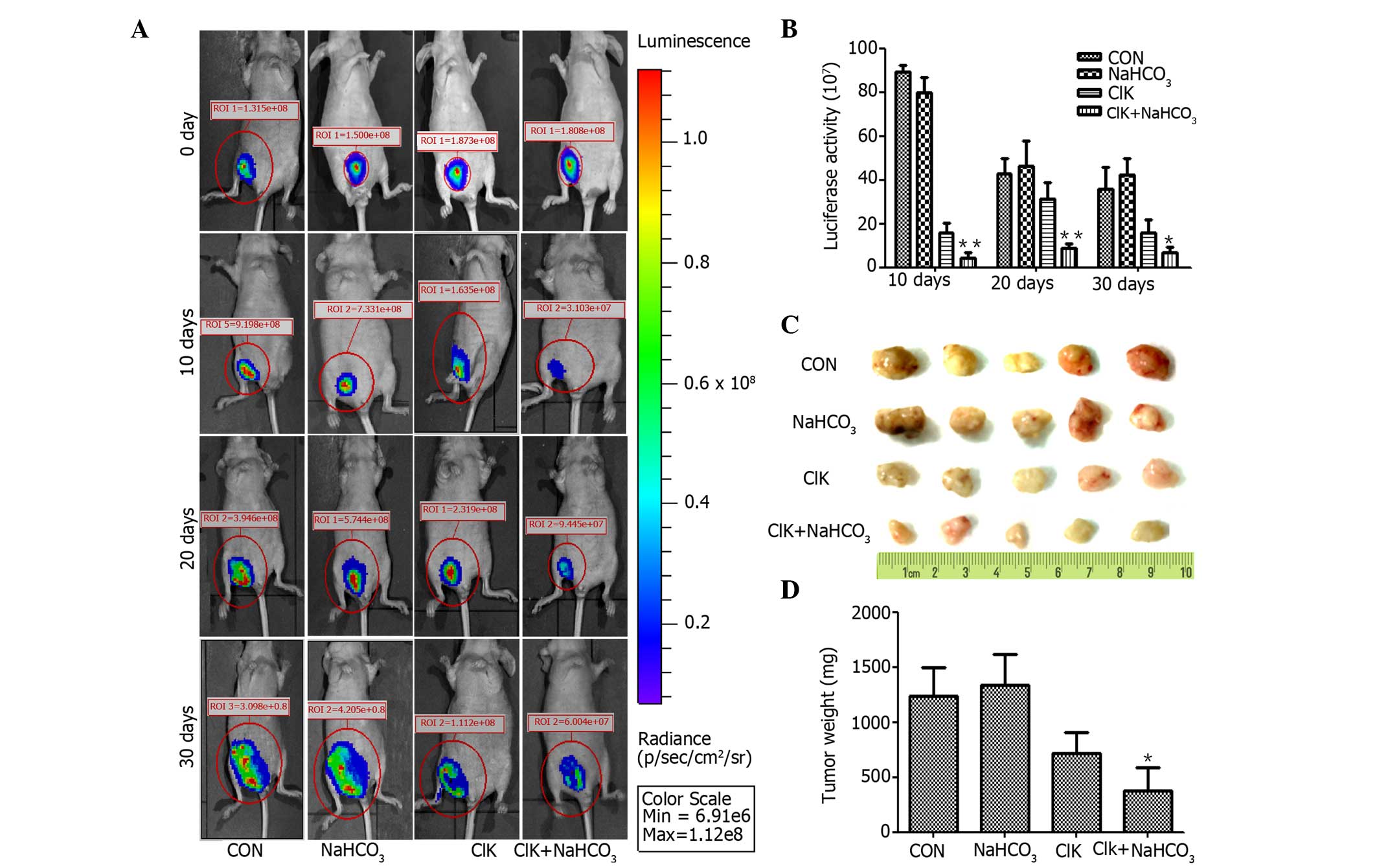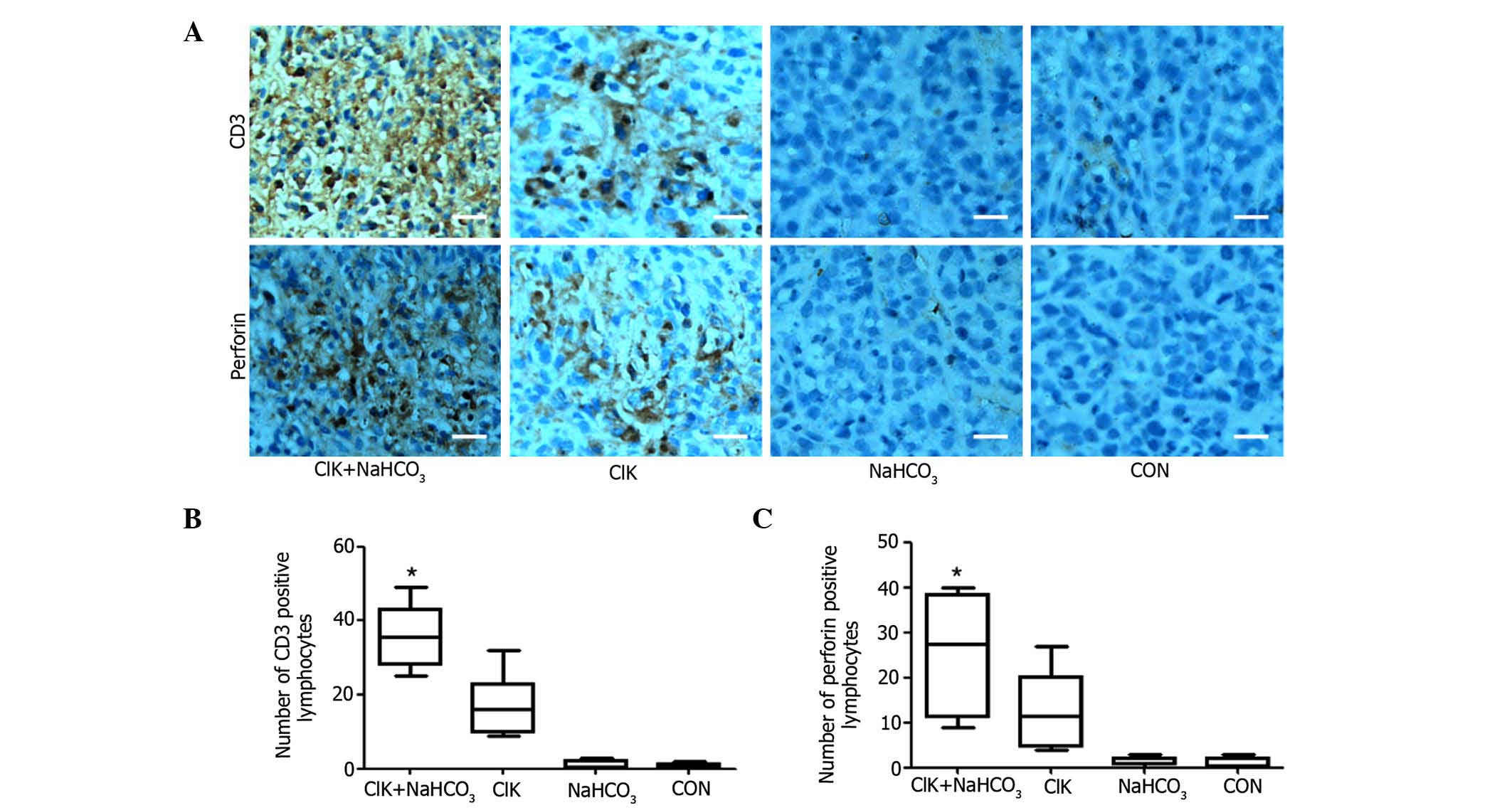NaHCO3 enhances the antitumor activities of cytokine-induced killer cells against hepatocellular carcinoma HepG2 cells
- Authors:
- Published online on: September 9, 2016 https://doi.org/10.3892/ol.2016.5112
- Pages: 3167-3174
-
Copyright: © Yuan et al. This is an open access article distributed under the terms of Creative Commons Attribution License.
Abstract
Introduction
Hepatocellular carcinoma (HCC), the most frequent primary tumor of the liver, is one of the leading causes of cancer-associated mortality worldwide (1). Regarding treatment options for HCC, immunotherapy remains an important adjuvant treatment, despite advances in surgery, chemotherapy and radiotherapy (2). Cytokine-induced killer (CIK) cell therapy is currently one of the most commonly used immunotherapies (3). In order to improve the efficacy of CIK cell therapy, numerous strategies, including gene transfection (4), stimulation with certain growth factors (5), pretreatment with antitumor drugs (6), or combination with genetically modified dendritic cells (7), have been attempted in practice. However, a number of clinical trials of CIK cell therapies failed to demonstrate any noticeable improvement over other therapeutic regimens, neither in terms of HCC control rates nor long-term survival rates (8), suggesting that other factors, such as the environment where CIK cells are functioning, should also be considered for immunotherapies.
It has been demonstrated that the high metabolic demand of rapidly proliferating cancer cells, in conjunction with a shift toward glycolytic metabolism reflecting both tumor hypoxia and oncogene-induced changes in gene expression, leads to an often greatly increased production and extrusion of acid by cancer cells (9,10). Therefore, the extracellular pH (pHe) of malignant solid tumors is usually acidic, ranging from 6.5 to 6.9, whereas the pHe of normal tissues is significantly more alkaline, ranging from 7.2 to 7.5 (11). This disturbance of the acid-base balance is able to remodel various physiological functions, and results in solid tumors becoming more invasive and metastatic (12). In addition, it may also induce undesired resistance to immunotherapy (13). By contrast, inhibition of the acid extrusion of tumor cells may alleviate their resistance to immunotherapy (14). However, none of these speculations has ever been confirmed for CIK cell immunotherapy in vitro or in vivo. In the present study, the antitumor activities of CIK cells against HepG2 cells were evaluated both in vitro and in vivo under environments with acidic and alkaline pH.
Materials and methods
Cell culture
HepG2 cells (ATCC, Manassas, VA, USA) or HepG2-luc cells (HepG2 cells stably transfected with a firefly luciferase gene), were cultured in Dulbecco's modified Eagle's medium (Invitrogen; Thermo Fisher Scientific, Inc., Waltham, MA, USA) containing 10% fetal bovine serum (Hyclone; GE Healthcare Life Sciences, Logan, UT, USA) in an incubator at 37°C with humidified atmosphere and 5% CO2 in air. Cells were adapted in acidic (pH 6.5) or alkaline (pH 7.4) environments for three passages prior to be used for experiments. The pH values of the medium were accordingly adjusted with lactic acid, NaHCO3 and 4-(2-hydroxyethyl)-1-piperazineethanesulfonic acid.
Preparation of CIK cells
Peripheral blood mononuclear cells (PBMCs) were isolated from peripheral blood by standard Ficoll separation, as previously described (5). Human peripheral blood samples were obtained with full informed consent from patients with HCC. In total, six samples were collected between January 2014 and July 2014 at the Department of Gastroenterology of Renmin Hospital, Hubei University of Medicine (Shiyan, China). The isolated cells were resuspended in RPMI-1640 medium supplemented with 1,000 U/ml interferon (IFN)-γ (R&D Systems, Inc., Minneapolis, MN, USA) and incubated at 37°C for 24 h. Then, recombinant human interleukin (IL)-2 protein (cat. no. 202-IL-050; R&D Systems, Inc.) and mouse anti-cluster of differentiation (CD)3 monoclonal antibody (cat. no. MAB100; dilution, 1:1,000; R&D Systems, Inc.) were added at 500 U/ml and 50 ng/ml, respectively. Subsequently, the cells were refreshed with RPMI-1640 medium supplemented with IL-2 (500 U/ml) every other day for 10 days prior to being subjected to flow cytometry analysis.
Flow cytometry
A set of conjugated monoclonal antibodies (BD Biosciences, Franklin Lakes, NJ, USA), including anti-CD3-fluorescein isothiocyanate (FITC; cat. no. 561806; dilution, 1:20) as a T-cell marker, anti-CD4-phycoerythrin (PE; cat. no. 565999; dilution, 1:20) as a helper T-cell marker, anti-CD8-PE (cat. no. 561950; dilution, 1:20) as a cytotoxic T-cell marker and anti-CD56-PE (cat. no. 561903; dilution, 1:20) as a natural killer (NK) cell-marker, were used to define the phenotypes of CIK cells. In total, 1×106 CIK cells were harvested and washed once with phosphate-buffered saline (PBS) containing 1% bovine serum albumin (BSA; Beyotime Institute of Biotechnology, Haimen, China), and resuspended in 100 µl PBS/BSA. The cells were then incubated with the above conjugated monoclonal antibodies separately for 20 min at 4°C, washed twice with PBS and resuspended in 400 µl PBS. Flow cytometric analysis was performed with a BD FACSCalibur™ flow cytometer (BD Biosciences), and the data were analyzed using the WinMDI software, version 2.9 (The Scripps Research Institute, La Jolla, CA, USA). The dead cells and debris were gated out.
HepG2 cell apoptosis was analyzed using the annexin V/propidium iodide (PI) double staining method
HepG2 cells were plated at a density of 3×105 cells/well in a BD Falcon® 12-well plate (BD Biosciences) and cultured in CIK cell-conditioned medium (CMCIK), HepG2 cell-conditioned medium (CMcontrol) or a 1:1 mixture of the two conditioned media (thus, the percentages of CMCIK in the above media were 100, 0 and 50%, respectively). The pH of the media was adjusted to 6.5 or 7.4, correspondingly. After 48 h of incubation, the cells were collected, washed and resuspended in PBS. Then, annexin V-FITC and PI (Nanjing KeyGen Biotech Co., Ltd., Nanjing, China) were added to the cells, which were incubated at 4°C for 20 min prior to being subjected to flow cytometer analysis. All the experiments were performed in triplicate.
3-(4,5-dimethylthiazol-2-yl)-2,5-diphenyltetrazolium bromide (MTT) assay
The MTT colorimetric assay was used to determine the cytotoxic activity of CIK cells against HepG2 cells in vitro (15). The CIK cells [effector (E) cells] and the HepG2 cells [target (T) cells] were co-cultured in a 96-well plate with medium at pH 6.5 or 7.4. The ratios of CIK and HepG2 cells (E/T ratio) were set as 10:1, 20:1, 40:1 and 80:1. In addition, E cells or T cells alone were used as controls. The MTT assay was performed 20 h later to evaluate the cell viability, and the optical density (OD) values were measured at 570 nm. The assays were conducted in triplicate. The cytotoxic activity was calculated as follows: Cytotoxic activity (%) = [1-(ODE+T-ODE)/ODT] × 100%.
Fluorescence assay of cytotoxic effects of CIK cells on HepG2-luc cells
HepG2-luc cells were co-cultured with CIK cells or in CMCIK at pH 6.5 or 7.4 respectively. The viability of HepG2-luc cells was assessed fluorescently using the IVIS® Spectrum in vivo imaging system (Caliper Life Sciences; PerkinElmer, Inc., Waltham, MA, USA). In co-culture, HepG2-luc cells were plated at a density of 8,000 cells/well into a BD Falcon® 96-well plate (BD Biosciences), and CIK cells were then added to the 96-well plate at E/T ratios of 0:1, 10:1, 20:1, 40:1 and 80:1. In culture with CMCIK, HepG2-luc cells were plated at a density of 1,500 cells/well in a BD Falcon® 96-well plate (BD Biosciences) with medium containing 0, 25, 50, 75 and 100% CMCIK. The assays were performed in triplicate. After 20 h of co-culture or 48 h of culture in CMCIK, 0.15 mg/ml D-luciferin was added into each well, and the luminescence activity (LA) was measured after additional 5-min incubation. Based on the LA values, the cytotoxicities of CIK cells were calculated according to the following formula: CIK cytotoxicity (%) = [(LA0:1-LAx:1)/LA0:1] × 100%, where LA0:1 is the LA of HepG2-luc cells cultured in the absence of CIK cells, and LAx:1 is a variable that refers to the LA of HepG2-luc cells co-cultured with 10, 20, 40 or 80-fold CIK cells. The cytotoxicities present in the CMCIK were calculated according to the following formula: CMCIK cytotoxicity (%) = [(LA0-LAy)/LA0] × 100%, where LA is the LA of the HepG2-luc cells, LA0 is the LA of HepG2-luc cells cultured in the absence of CMCIK, and LAy is a variable that represents the LA of HepG2-luc cells cultured with 25, 50, 75 and 100% CMCIK.
Xenograft assay
A total of 20 female nude mice (6–8 weeks-old) were purchased from the Animal Experiment Center of Wuhan University (Wuhan, China). All mice were maintained in the Animal Experiment Center of the Hubei University of Medicine (Shiyan, China) at a controlled temperature and humidity, under a 12-h light/dark cycle, with ad libitum access to sterile food and water. The present study was performed with the approval of the Hubei University of Medicine ethical committee, and all the experiments were performed according to the National Institutes of Health Guide for the Care and Use of Laboratory Animals. In order to eradicate residual NK cells, the nude mice were administered 200 cGy of whole body irradiation and subcutaneously injected with 1×107 HepG2-luc cells. Subsequently, the mice were randomly divided into four groups according to the different treatments received: i) CIK cells injection plus oral administration of NaHCO3; ii) CIK cells injection plus drinking water feeding; iii) normal saline injection plus oral administration of NaHCO3; and iv) normal saline injection plus drinking water feeding (which served as control). CIK cells (1.5×107 cells/injection) or an equivalent volume of normal saline were intravenously injected in the mice through their tail veins on days 0, 7, 14, 21 and 28, while NaHCO3 (200 mmol/l) or drinking water feeding were conducted on a daily basis. The LA of the tumors was monitored and measured with the IVIS® Spectrum in vivo imaging system on days 0, 10, 20 and 30. The mice were sacrificed on day 30, and the tumor weights were measured.
Immunohistochemical analysis
The grafted tumor masses were fixed in 10% formalin, embedded in paraffin and sectioned with a thickness of 3 µm for immunohistochemical studies. Rabbit anti-human CD3 polyclonal antibody (cat. no. ab828; dilution, 1:50; Abcam, Cambridge, MA, USA) and mouse anti-human perforin monoclonal antibody (cat. no. ab47225; dilution, 1:50; Abcam) were used for immunostaining. Horseradish peroxidase-conjugated goat anti-rabbit (cat. no. ab6721; dilution, 1:1,000; Abcam) and goat anti-mouse (cat. no. ab6789; dilution, 1:1,000; Abcam) secondary antibodies were used for detection of the primary antibodies. All procedures were conducted according to the manufacturer's protocol. Images of the sections were acquired using an Olympus BX-60 microscope (Olympus Corporation, Tokyo, Japan) to determine the CD3+ and perforin+ cell densities. The number of positive cells was blindly counted in 10 randomly selected independent fields (0.16 mm2 at ×400 magnification) for each section by two independent observers.
Statistical analysis
Differences between groups were compared using analysis of variance, and the least significant difference test was used for multiple mean comparisons. P<0.05 was considered to indicate a statistically significant difference. Statistical analysis was conducted using SPSS software v13.0 (SPSS Inc., Chicago, IL, USA).
Results
Characteristics of CIK cells
The CIK cells induced with the method described above appeared regular, round, transparent and variable in size when observed under a microscope. They exhibited the ability of growth in suspension, and multiple characteristic cell clusters were formed (Fig. 1A and B). After 14 days, the absolute number of human PBMCs cultured in the presence of IL-2 and anti-CD3 antibody increased by >250-fold, from 5 million PBMCs to 1,300 million CIK cells. When the phenotypes of the cultured cell population were examined by fluorescence-activated cell sorting analysis, the cell population was observed to be composed of 92% CD3+, 34% CD3+ CD56+, 14% CD4+ and 73% CD8+ cells (Fig. 1C).
The cytotoxic activity of CIK cells is significantly compromised under an acidic environment
Both the MTT assay and the fluorescence assay demonstrated that CIK cells had a significantly higher cytotoxic activity against HepG2-luc cells in the medium with pH 7.4 than in the medium with pH 6.5. In the fluorescence assay, HepG2-luc cells were co-cultured with CIK cells at an E/T ratio of 0:1 10:1, 20:1, 40:1 or 80:1 at pH 6.5 or pH 7.4. The fluorescence intensities were significantly lower with pH 7.4 than with pH 6.5 for each paired cultures (P<0.05; Fig. 2A and B). The cytotoxic activity calculated based on the fluorescence intensity showed that the cytotoxicity of CIK cells were significantly higher with pH 7.4 than with pH 6.5 (P<0.05; Fig. 2C).
In the MTT assay, 19, 38, 60 and 80% of HepG2-luc cells died when co-cultured with CIK cells at an E/T ratio of 10:1, 20:1, 40:1 and 80:1, respectively, in the medium with pH 7.4. However, only 4, 18, 30 and 45% of HepG2 cells died, respectively, at the same E/T ratios with pH 6.5 (P<0.05; Fig. 2D). Highly consistent with the results of CIK cells in fluorescence assay, the CMCIK displayed stronger cytotoxicity activities in pH 7.4 condition than in pH 6.5 condition. The fluorescence intensities of HepG2-luc cells cultured in medium containing 50, 75 and 100% CMCIK were significantly lower with pH 7.4 than with pH 6.5 (P<0.05; Fig. 3A and B). The cytotoxicity of CMCIK in pH 7.4 condition was stronger than that in the pH 6.5 condition (Fig. 3C).
In addition, the annexin V/PI double staining method was used to determine the percentage of cells that exhibited apoptosis and necrosis (Fig. 4). At a CM ratio of 50%, the CMCIK-induced apoptosis and necrosis in pH 6.5 and pH 7.4 medium were 15 and 26%, respectively. Furthermore, at a CMCIK ratio of 100%, the percentage of apoptosis and necrosis in pH-6.5 and pH-7.4 medium were 25 and 45%, respectively. These results indicated that the acidic environment inhibits the antitumor activity of CIK cells.
The activity of CIK cells against HCC is enhanced by NaHCO3 feeding in nude mice
In order to further investigate whether NaHCO3 treatment would enhance the antitumor activity of CIK therapy in vivo, HepG2-luc carcinoma-bearing nude mice were grouped and treated as above described. Nude mice were selected due to their lack of cellular immunity (16). The results revealed that there was no difference between the NaHCO3 feeding group and the control group in terms of luminescence intensities from the tumors. The luminescence intensities of the tumors in the CIK group were significantly reduced compared with those in the control group, while those in the CIK plus NaHCO3 feeding group were also significantly reduced compared with those in the CIK group (Fig. 5A and B). The tumor masses were isolated on day 30 (Fig. 5C) after grafted from each group, and the average weights of the tumors were consistent with the luminescence intensity analysis (Fig. 5D).
NaHCO3 enhances the infiltration of CIK cells within the tumor tissue
Since CD3+ T lymphocytes are the main components of CIK cells and perforin is important in the antitumor effects of CIK cells (17), an immunohistochemical study was further performed on the excised tumor tissue with anti-CD3 and anti-perforin antibodies. The results revealed that there was significantly more accumulation of CD3+ T lymphocytes and perforin in tumor tissue treated with CIK cells plus NaHCO3 compared with tumor tissue treated with CIK cells alone (Fig. 6). There were almost no accumulation of CD3+ T lymphocytes or perforin in the tumor tissue from the other two groups. This result could explain why tumor growth was remarkably suppressed in the CIK+NaHCO3 group.
Discussion
The acidic pH of the extracellular environment has a direct influence on a broad range of immunological functions (18). Previous studies on polymorphonuclear leukocytes demonstrate that this acidic pH mainly causes inhibition of chemotaxis, respiratory activity and bactericidal capacity (19,20). Evidence of impaired lymphocyte cytotoxicity and proliferation at acidic pH is also beginning to emerge (21). In addition, clinical acidosis is accompanied by immunodeficiency (22). Furthermore, other evidence has suggested that acidic microenvironments may play a role during neoplastic growth and invasion (23).
CIK cells are ex vivo-expanded T lymphocytes that share phenotypic and functional properties with both NK and T cells (24). In view of the conclusions of previous studies, it is reasonable for us to infer that acidic microenvironments of solid tumors will affect the antitumor activity of CIK cells. Based on the mechanism underlying the antitumor effects of CIK cells, including the fact that CIK cells bind to T cells, form cellular conjugates with tumor cells and secrete a large number of cytotoxic cytoplasmic granules that are cytolytic to T cells (25), and the fact that CIK cells secrete a number of cytokines (including IFN-γ, IL-2 and tumor necrosis factor) that attack tumor cells (26), the present study compared the antitumor activities of CIK cells or CMCIK against HCC at pH 6.5 and 7.4. The results revealed that the antitumor activities of both CIK cells and CMCIK against HepG2 cells were significantly compromised under an acidic environment, with 35 and 25% reduction in cytotoxicity and tumor inhibition, respectively. These results strongly suggested that neutralization of the acidic environment in the tumor tissue should be equally important as the CIK cell therapy itself. CIK cells would not be fully active unless the acidic environment in tumor tissue is neutralized.
Previous experimental and mathematical models have successfully demonstrated that it is possible to upregulate the pHe of tumors with little effect on systemic pH by chronic administration of sodium bicarbonate (27,28). In addition, recent studies documented that oral administration of HCO3− could actually inhibit tumor metastasis in prostate, breast and colon cancer cell line-derived tumors (29–31). This apparently occurred by reducing the extracellular acidity of the acid-extruding tumors, in the absence of changes in the pH of the blood or normal tissues (29–31). Previous findings suggested that certain enzymes such as cathepsins and matrix metalloproteases, which are involved in tumor invasion, were inhibited by alkalinization (32). In the present study, oral administration of NaHCO3 was combined with CIK cell therapy in HCC-bearing nude mice to investigate whether NaHCO3 could enhance the antitumor activity of CIK cells against HCC. The present data revealed a remarkable synergy between oral administration of NaHCO3 and CIK cell therapy in treating grafted HepG2-luc carcinomas in nude mice, suggesting that oral NaHCO3 administration may be sufficient to reduce the acidity of the tumor microenvironment, eventually enhancing the efficacy of CIK cell therapy. These findings and the in vitro results could explain one of the reasons why tumor cells thrive in the acidic environment, that is, due to the fact that the immune system is compromised in the acidic environment, thus facilitating the survival of tumor cells. Notably, oral administration of NaHCO3 alone failed to inhibit the growth of the tumor in nude mice. This result was consistent with a previous study (28), in which NaHCO3 administration was observed to have no effect on the growth of primary tumors in severe combined immunodeficiency mice. Thus, although NaHCO3 inhibits spontaneous metastases by attenuating the function of certain enzymes, without the immune system, NaHCO3 is unable to inhibit the primary tumor growth. However, this is not the true situation of the patients with tumors in the clinic, since the majority of these patients are immunologically intact (33). Therefore, even without receiving any immunotherapy such as CIK cell therapy, it would be beneficial for these patients to ingest alkaline food or drinks, since it may aid the T lymphocytes to fight against the tumor cells in their bodies.
The present immunohistochemical studies on the tumor tissue from each group revealed a significantly augmented number of CD3+ T lymphocytes infiltrating into the tumor mass when NaHCO3 feeding was combined with CIK cell therapy, compared with CIK cell therapy alone. In addition, the perforin secreted by T lymphocytes, which is important in killing T cells, was also abundantly detected by immunohistochemistry. These results suggest that the acidic environment appeared to prevent CIK cells from migrating into the tumor tissue, which may partially explain why immune cells such as CIK cells could not function well in an acidic environment. However, there may be other mechanisms involved, such as the acidic environment inhibiting the cytokine secretion of CIK cells, thus compromising their binding ability to the T cells. Further studies to explore the exact molecular mechanisms are warranted.
In summary, both the in vitro and in vivo experiments of the present study demonstrated that the antitumor activities of CIK cells against HepG2 cells were significantly enhanced under alkaline or relatively less acidic environments, although the molecular mechanism involved require to be further investigated. The present results have provided novel insights for oncologists to treat their cancer patients, particularly when immunotherapy is considered.
Acknowledgements
The present study was supported by grants from the Ministry of Education of China (Beijing, China; grant no. 20151092900), the Science and Technology Department of Hubei Province (Wuhan, China; grant no. 2014CFA068) and the Science and Technology Department of Shiyan City (Shiyan, China; grant no. 16Y01).
References
|
El-Serag HB: Epidemiology of viral hepatitis and hepatocellular carcinoma. Gastroenterology. 142:1264.e1–1273.e1. 2012. View Article : Google Scholar | |
|
Su Y, Yang Y, Ma Y, Zhang Y, Rao W, Yang G and Kou C: The Efficacy and Safety of Dendritic Cells Co-Cultured with Cytokine-Induced Killer Cell Therapy in Combination with TACE-Predominant Minimally-Invasive Treatment for Hepatocellular Carcinoma: A Meta-Analysis. Clin Lab. 62:599–608. 2016.PubMed/NCBI | |
|
Zhang L, Zhu W, Li J, Yang X, Ren Y, Niu J and Pang Y: Clinical outcome of immunotherapy with dendritic cell vaccine and cytokine-induced killer cell therapy in hepatobiliary and pancreatic cancer. Mol Clin Oncol. 4:129–133. 2016.PubMed/NCBI | |
|
Schmidt-Wolf IG, Finke S, Trojaneck B, Denkena A, Lefterova P, Schwella N, Heuft HG, Prange G, Korte M, Takeya M, et al: Phase I clinical study applying autologous immunological effector cells transfected with the interleukin-2 gene in patients with metastatic renal cancer, colorectal cancer and lymphoma. Br J Cancer. 81:1009–1016. 1999. View Article : Google Scholar : PubMed/NCBI | |
|
Rettinger E, Meyer V, Kreyenberg H, Volk A, Kuçi S, Willasch A, Koscielniak E, Fulda S, Wels WS, Boenig H, et al: Cytotoxic capacity of IL-15-stimulated cytokine-induced killer cells against human acute myeloid leukemia and rhabdomyosarcoma in humanized preclinical mouse models. Front Oncol. 2:322012. View Article : Google Scholar : PubMed/NCBI | |
|
Huang X, Chen YT, Song HZ, Huang GC and Chen LB: Cisplatin pretreatment enhances antitumor activity of cytokine-induced killer cells. World J Gastroenterol. 17:3002–3011. 2011. View Article : Google Scholar : PubMed/NCBI | |
|
Wang D, Zhang B, Gao H, Ding G, Wu Q, Zhang J, Liao L and Chen H: Clinical research of genetically modified dendritic cells in combination with cytokine-induced killer cell treatment in advanced renal cancer. BMC Cancer. 14:2512014. View Article : Google Scholar : PubMed/NCBI | |
|
Xie F, Zhang X, Li H, Zheng T, Xu F, Shen R, Yan L, Yang J and He J: Adoptive immunotherapy in postoperative hepatocellular carcinoma: A systemic review. PLoS One. 7:e428792012. View Article : Google Scholar : PubMed/NCBI | |
|
Cantor JR and Sabatini DM: Cancer cell metabolism: One hallmark, many faces. Cancer Discov. 2:881–898. 2012. View Article : Google Scholar : PubMed/NCBI | |
|
Andersen AP, Moreira JM and Pedersen SF: Interactions of ion transporters and channels with cancer cell metabolism and the tumour microenvironment. Philos Trans R Soc Lond B Biol Sci. 369:201300982014. View Article : Google Scholar : PubMed/NCBI | |
|
Gallagher FA, Kettunen MI, Day SE, Hu DE, Ardenkjaer-Larsen JH, Zandt RI, Jensen PR, Karlsson M, Golman K, Lerche MH and Brindle KM: Magnetic resonance imaging of pH in vivo using hyperpolarized 13C-labelled bicarbonate. Nature. 453:940–943. 2008. View Article : Google Scholar : PubMed/NCBI | |
|
Rofstad EK, Mathiesen B, Kindem K and Galappathi K: Acidic extracellular pH promotes experimental metastasis of human melanoma cells in athymic nude mice. Cancer Res. 66:6699–6707. 2006. View Article : Google Scholar : PubMed/NCBI | |
|
Barar J and Omidi Y: Dysregulated pH in tumor microenvironment checkmates cancer therapy. Bioimpacts. 3:149–162. 2013.PubMed/NCBI | |
|
von Schwarzenberg K, Lajtos T, Simon L, Müller R, Vereb G and Vollmar AM: V-ATPase inhibition overcomes trastuzumab resistance in breast cancer. Mol Oncol. 8:9–19. 2014. View Article : Google Scholar : PubMed/NCBI | |
|
Ferrari M, Fornasiero MC and Isetta AM: MTT colorimetric assay for testing macrophage cytotoxic activity in vitro. J Immunol Methods. 131:165–172. 1990. View Article : Google Scholar : PubMed/NCBI | |
|
Pyo KH, Jung BK, Xin CF, Lee YW, Chai JY and Shin EH: Prominent IL-12 production and tumor reduction in athymic nude mice after Toxoplasma gondii lysate antigen treatment. Korean J Parasitol. 52:605–612. 2014. View Article : Google Scholar : PubMed/NCBI | |
|
Chen JH, Xiang JY, Ding GP and Cao LP: Cholangiocarcinoma-derived exosomes inhibit the antitumor activity of cytokine-induced killer cells by down-regulating the secretion of tumor necrosis factor-α and perforin. J Zhejiang Univ Sci B. 17:537–544. 2016. View Article : Google Scholar : PubMed/NCBI | |
|
Lardner A: The effects of extracellular pH on immune function. J Leukoc Biol. 69:522–530. 2001.PubMed/NCBI | |
|
Rabinovich M, DeStefano MJ and Dziezanowski MA: Neutrophil migration under agarose: Stimulation by lowered medium pH and osmolality. J Reticuloendothel Soc. 27:189–200. 1980.PubMed/NCBI | |
|
Leblebicioglu B, Lim JS, Cario AC, Beck FM and Walters JD: pH changes observed in the inflamed gingival crevice modulate human polymorphonuclear leukocyte activation in vitro. J Periodontol. 67:472–477. 1996. View Article : Google Scholar : PubMed/NCBI | |
|
Loeffler DA, Juneau PL and Masserant S: Influence of tumour physico-chemical conditions on interleukin-2-stimulated lymphocyte proliferation. Br J Cancer. 66:619–622. 1992. View Article : Google Scholar : PubMed/NCBI | |
|
Kellum JA, Song M and Li J: Science review: Extracellular acidosis and the immune response: Clinical and physiologic implications. Crit Care. 8:331–336. 2004. View Article : Google Scholar : PubMed/NCBI | |
|
Kraus M and Wolf B: Implications of acidic tumor microenvironment for neoplastic growth and cancer treatment: A computer analysis. Tumour Biol. 17:133–154. 1996. View Article : Google Scholar : PubMed/NCBI | |
|
Nishimura R, Baker J, Beilhack A, Zeiser R, Olson JA, Sega EI, Karimi M and Negrin RS: In vivo trafficking and survival of cytokine-induced killer cells resulting in minimal GVHD with retention of antitumor activity. Blood. 112:2563–2574. 2008. View Article : Google Scholar : PubMed/NCBI | |
|
Pievani A, Borleri G, Pende D, Moretta L, Rambaldi A, Golay J and Introna M: Dual-functional capability of CD3+CD56+CIK cells, a T-cell subset that acquires NK function and retains TCR-mediated specific cytotoxicity. Blood. 118:3301–3310. 2011. View Article : Google Scholar : PubMed/NCBI | |
|
Miao L, Run-Ming J and Yi J: T-Bet mediated anti-neoplastic effects of dendritic cell-cytokine induced killer cells in vitro. Iran J Pediatr. 22:43–51. 2012.PubMed/NCBI | |
|
Martin NK, Gaffney EA, Gatenby RA, Gillies RJ, Robey IF and Maini PK: A mathematical model of tumour and blood pHe regulation: The HCO3-/CO2 buffering system. Math Biosci. 230:1–11. 2011. View Article : Google Scholar : PubMed/NCBI | |
|
Robey IF, Baggett BK, Kirkpatrick ND, Roe DJ, Dosescu J, Sloane BF, Hashim AI, Morse DL, Raghunand N, Gatenby RA and Gillies RJ: Bicarbonate increases tumor pH and inhibits spontaneous metastases. Cancer Res. 69:2260–2268. 2009. View Article : Google Scholar : PubMed/NCBI | |
|
Wojtkowiak JW, Verduzco D, Schramm KJ and Gillies RJ: Drug resistance and cellular adaptation to tumor acidic pH microenvironment. Mol Pharm. 8:2032–2038. 2011. View Article : Google Scholar : PubMed/NCBI | |
|
Estrella V, Chen T, Lloyd M, Wojtkowiak J, Cornnell HH, Ibrahim-Hashim A, Bailey K, Balagurunathan Y, Rothberg JM, Sloane BF, et al: Acidity generated by the tumor microenvironment drives local invasion. Cancer Res. 73:1524–1535. 2013. View Article : Google Scholar : PubMed/NCBI | |
|
Silva AS, Yunes JA, Gillies RJ and Gatenby RA: The potential role of systemic buffers in reducing intratumoral extracellular pH and acid-mediated invasion. Cancer Res. 69:2677–2684. 2009. View Article : Google Scholar : PubMed/NCBI | |
|
Robey IF and Nesbit LA: Investigating mechanisms of alkalinization for reducing primary breast tumor invasion. Biomed Res Int. 2013:4851962013. View Article : Google Scholar : PubMed/NCBI | |
|
Chu H, Du F, Jiang L, Wang Z, Gong Z, Lian P, Li P and Chen J: The Efficacy of CIK-Based Immunotherapies for Advanced Solid Tumors. Technol Cancer Res Treat. Jul 19–2016.(Epub ahead of print). |



